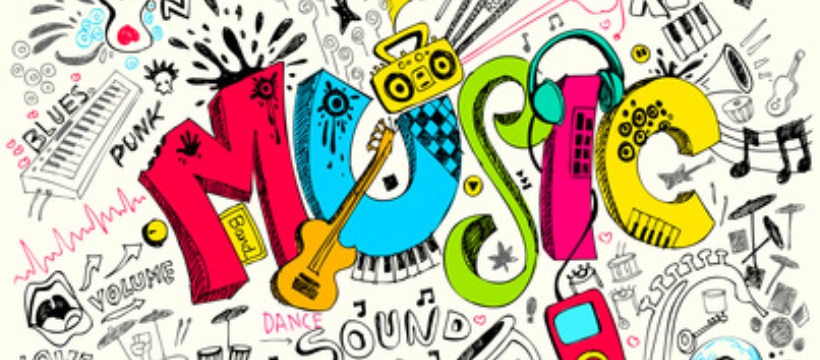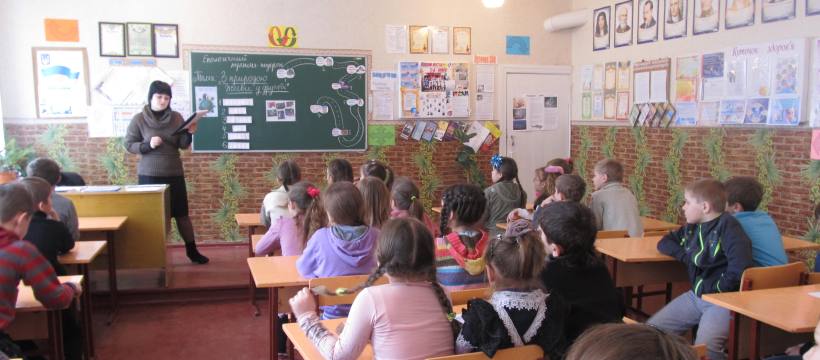Система уроків з англійської мови в 8 класі за підручником Людмили Біркун «Our English» з теми: «Музика»
Урок-екскурсія у 8 класі на тему:
"З історії американського джазу"
Topic: American Music - Jazz
Type of the Lesson: combined
Practical goals: to practice pupils’ skills in listening, speaking
Educational goals: to enlarge pupils’ knowledge about American music
Developing goals: to form pupils’ musical tastes
Upbringing goals: to bring up to understand musical culture of American music
Equipment: pictures, posters of famous American musicians and singers, different varicoloured balloons, tape recorder.
Lesson Structure
I. Introduction to the lesson.
1. Greeting and Aim.
T. Today we are going to have a very unusual lesson. You can see some things and pictures which are connected with the topic of our lesson. (Pictures of musical instruments and singers). So the topic of our lesson is “American Music – Jazz”. As you know, music is everywhere in our lives. We hear it on the radio, on TV, in the streets, in shops and cafes, everywhere. Today we will learn about jazz. The aim of the lesson is to learn about the history of jazz, including a famous musician. On the way, we’ll learn new vocabulary and practice our listening skills.
2. Warming up.
T. We have learned about many types of music. Listen to the piece of music and guess its genre and match the definition.
Country music
a style of popular music that has an exciting rhythm and is usually played by groups of musicians using drums, saxophones, trumpets, etc
popular music in the style of white people’s folk music of the southern United States
Jazz
Blues
a type of music which is like jazz,
but is always slow and sounds sad
Rock-n-roll
a kind of music with a strong beat that
was sung and played by small groups of people
II. The Main Part of the Lesson
1. Presentation of New Material. Reading.
T. Jazz is a very popular style of music in the United States and all over the world. Now we will take turns reading about it and its history.
a) Pre-Reading Activity
T. Match the words with their definitions. Find the corresponding pictures on the blackboard.
a) trumpet – 1) a musical instrument made of skin stretched over a circular frame, played by hitting it with your hand or a stick;
b) to improvise – 2) a musical instrument that you blow into, which consists of a curved metal tube that is wide at the end, and three buttons you press to change the notes;
c) ragtime – 3) to be a sign of something, to show or be a sign of a particular situation or feeling;
d) gospel – 4) a curved musical instrument of metal that you play by blowing into it and pressing buttons, used especially in popular music and jazz
e) to reflect – 5) a type of music and dancing that has a strong beat and was popular in the early part of the 20th century;
f) to determine - 6) a type of Christian music in which religious songs are sung very loudly;
g) drum – 7) to do something without any preparation, because you are forced to do this by unexpected events;
h) saxophone – 8) to decide something
b) While-Reading Activity
Jazz is a style of popular music that has an exciting rhythm and strong beat. It is usually played by groups of musicians using drums, saxophones, trumpets and other wind instruments.
It is important to know that jazz is improvised music. It is not planned. The great jazz musicians are individual players and not really composers. Jazz grew out of Negro blues, ragtime, gospel, black spiritual songs, West African rhythms and European harmonies. Jazz originated among black people in New Orleans in about 1900. In the 1920s in New Orleans beautiful music filled the streets and cafes. The black and poor singers sang about their hard lives.
Then their music traveled to Europe. It was the time when the black music entered the whites’ culture changing the lifestyle of the people all over the world. Ever since the 1930s music was not just a way to relax. From that time on music began to reflect and determine the people’s way of life.
One of the most famous jazz musicians of all the times is Louis Armstrong. Louis Armstrong loved music from a very early age and liked to listen to street bands at parades. He began to play music at school and in 1924 he got his own band. He started traveling with it. Later he organized several large bands. He introduced new ideas to jazz and was known as the “King of Jazz.”
c) Post-Reading Activity.
1). Comprehension Questions.
1. What style or kind of music is jazz?
2. What is important about jazz?
3. What instruments do jazz musicians play?
4. Where did jazz originate?
5. Who is the “King of Jazz”? Why?
2). Pair Work.
T. Now make up a dialogue using the text.
2. Listening
a) Pre
-Listening Activity.Writing.
T. Now that we know more about jazz, we will listen to a song by Louis Armstrong. Before we listen, let’s take turns reading the words. As you see there are some words missing. Can you complete any of the following lines? As you listen to it, try to write the words that you hear.
What a Wonderful World
I see … of green,
Red … too.
I see them … for me and you,
And I think to myself
What a wonderful world.
I see … of blue,
And … of white, the bright… day
And I think to myself
What a wonderful world.
The … of the rainbow
So pretty in the sky
Are also on the …
Of the people going by.
I see friends shaking … .
Saying, “How do you do?
They’re really saying
“I … you”.
I hear … cry,
I watch them grow.
They’ll … much more
Than you’ll ever know,
And I think to myself
What a wonderful world.
Yes, I think to myself
What a wonderful world.
Keys: trees, roses, bloom, skies, clouds, sunny, starry, colours, faces, hands, love, babies, learn.
b) While –Listening Activity.
T. What is this song about?
I will play the song one-more time. Listen to the rhythm and words.
c) Post-Listening Activity. Speaking.
T. Now let’s share what we heard. How do you think what the singer feels? (Possible answers: to feel aloneness, because the song is sad; to remind the sea and waves, etc.)
3. Questionnaire.
T. Now you will stand up, take an interview using the questionnaire and find how musical you are in the form? How Musical are you?
1. Which instruments do you play…
a) very well? (3 for each) ___________________________
b) quite well? (2 for each)______________________________
c) a little? (1 for each)_________________________________
d) not at all? (0) __________________________________
2. Is music important to you?
a) Yes. (5)
b) Sometimes. (3)
c) It depends on the kinds of music. (2)
d) No. (0)
3. How often do you sit down and listen to music?
a) Every day. (4)
b) Most days. (3)
c) Some days. (2)
d) Never. (0)
4. How many concerts did you go to last year?
a) More than 5. (4).
b) 2-5. (3)
c) 1. (1)
d) None. (0)
5. How many CDs and / or cassettes have you got?
a) So many you can’t count. (4)
b) 20-40. (3)
c) About 10. (2).
d) None. (0)
6. Where and when do you listen to music? (1point for each.)
a) In the sitting room.
b) In your room.
c) In bed.
d) In transport.
e) While you’re working.
f) While you’re studying.
g) When you’re doing sport.
h) Your variant ____________________________________
Add up your score.
25-30: You’re music mad! Take your earphones off and listen to your teacher!
20-25: You like music but you know there are other things in life.
10-20: You like other things more than music.
0-10: It’s OK. Music is for birds.
III. Conclusion of the Lesson.
1. Homework.
T. Make up your projects about other kinds or styles of American Music.
2. Daily Marks.
3. Summarising.
T. I think you liked our lesson. But what was the most difficult for you? What was the easiest?








